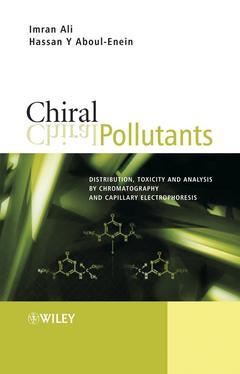Chiral Pollutants Distribution, Toxicity and Analysis by Chromatography and Capillary Electrophoresis
Auteurs : Ali Imran, Aboul-Enein Hassan Y.

Acknowledgements.
About the Book.
About the Authors.
1 Introduction.
1.1 The Importance of the Environment.
1.2 Environmental Pollutants.
1.3 Chirality and its Occurrence.
1.4 The Chemical Evolution of Chirality.
1.5 The Electronic Theory of Chirality.
1.6 The Importance of Chirality.
1.7 Nomenclature for Chiral Pollutants.
1.8 Chirality in Environmental Pollutants.
1.9 Chirality and its Consequences in the Environment.
1.10 The Enantiomeric Ratio and Fractions of Chiral Pollutants.
1.11 Methods for the Separation of Chiral Pollutants.
1.11.1 Chromatographic Methods.
1.11.2 The Capillary Electrophoretic Method.
1.12 Chiral Selectors in Chromatography and Capillary Electrophoresis.
1.13 Detection in Chromatography and Capillary Electrophoresis.
1.14 Other Methods of Separation of Chiral Pollutants.
References.
2 Chiral Pollutants: Sources and Distribution.
2.1 Introduction.
2.2 Sources of Contamination.
2.3 The Distribution of Chiral Pollutants.
2.3.1 Distribution in Water.
2.3.2 Distribution in Sediment.
2.3.3 Distribution in Soil.
2.3.4 Distribution in Air.
2.3.5 Distribution in Aquatic and Amphibian Biota.
2.3.6 Distribution in Terrestrial Biota.
2.3.7 Distribution in Food Products.
2.4 Conclusions.
References.
3 Chiral Pollutants: Biotransformation, Biodegradation and Metabolism.
3.1 Introduction.
3.2 The Mechanisms of the Interactions of Chiral Xenobiotics in Biological Systems.
3.3 The Fate of Chiral Pollutants in the Ecosystem.
3.3.1 Biotransformation.
3.4 Photochemical Conversion.
3.5 Metabolism.
3.6 Conclusions.
References.
4 The Enantioselective Toxicities of Chiral Pollutants.
4.1 Introduction.
4.2 The Enantioselective Toxicities of PCBs.
4.3 The Enantioselective Toxicities of HCH.
4.4 The Enantioselective Toxicities of Other Chlorinated Pesticides.
4.5 The Enantioselective Toxicities of Phosphorous Pesticides.
4.6 The Enantioselective Toxicities of Polyaromatic Hydrocarbons (PAHs).
4.7 The Enantioselective Toxicities of Other Xenobiotics.
4.8 The Enantioselective Toxicities of Drugs and Pharmaceuticals.
4.9 Conclusions.
References.
5 Sample Preparation.
5.1 Introduction.
5.2 Sampling.
5.3 Filtration.
5.4 Homogenization.
5.5 Extraction.
5.5.1 The Extraction of Solid Samples.
5.5.2 The Extraction of Liquid Samples.
5.6 Membrane Methods in Sample Preparation.
5.7 Clean-up.
5.8 Pre-concentration.
5.9 Conclusions.
References.
6 The Analysis of Chiral Pollutants by Gas Chromatography.
6.1 Introduction.
6.2 Chiral Selectors.
6.2.1 Structures and Properties.
6.2.2 Preparation and Commercialization.
6.2.3 Other Chiral GC CSPs.
6.3 Applications.
6.4 The Optimization of GC Conditions.
6.4.1 Mobile Phases.
6.4.2 Temperature.
6.4.3 The Column Dimensions.
6.4.4 Structures and Types of Chiral Selectors.
6.4.5 The Structures of Chiral Pollutants.
6.4.6 Detection.
6.4.7 Other Parameters.
6.5 The Reverse Elution Order.
6.6 Errors and Problems in Enantioresolution.
6.7 The Derivatization of Chiral Environmental Pollutants.
6.8 Mechanisms of Chiral Resolution.
6.9 Conclusions.
References.
7 The Analysis of Chiral Pollutants by High Performance Liquid Chromatography.
7.1 Introduction.
7.2 Chiral Selectors.
7.3 Applications.
7.4 The Optimization of HPLC Conditions.
7.4.1 Polysaccharide CSPs.
7.4.2 Cyclodextrin CSPs.
7.4.3 Macrocyclic Glycopeptide Antibiotic CSPs.
7.4.4 Protein CSPs.
7.4.5 Chiral Crown Ether CSPs.
7.4.6 Ligand Exchange CSPs.
7.4.7 Pirkle-type CSPs.
7.5 Detection.
7.6 Chiral Recognition Mechanisms.
7.7 Conclusions.
References.
8 The Analysis of Chiral Pollutants byMicellar Electrokinetic, Capillary Electrochromatographic, Supercritical Fluid and Thin Layer Chromatographic Techniques.
8.1 Introduction.
8.2 Chiral Selectors.
8.3 Micellar Electrokinetic Chromatography (MEKC).
8.4 Capillary Electrochromatography (CEC).
8.5 Supercritical Fluid Chromatography (SFC).
8.6 Thin Layer Chromatography (TLC).
8.7 LC versus GC.
8.8 Conclusions.
References.
9 The Analysis of Chiral Environmental Pollutants by Capillary Electrophoresis.
9.1 Introduction.
9.2 Chiral Selectors.
9.3 Applications.
9.4 The Optimization of CE Conditions.
9.4.1 The Composition of the Background Electrolyte.
9.4.2 The pH of the Background Electrolyte.
9.4.3 The Ionic Strength of the Background Electrolyte.
9.4.4 Structures and Types of Chiral Selectors.
9.4.5 The Applied Voltage.
9.4.6 Temperature.
9.4.7 The Structures of Chiral Pollutants.
9.4.8 Organic Modifiers.
9.4.9 Other Parameters.
9.4.10 Optimization by Dependent Variables.
9.5 Detection.
9.6 Validation of Methods.
9.7 Mechanisms of Chiral Resolution.
9.8 CE versus HPLC.
9.9 Conclusions.
References.
10 Perspectives on the Analysis of Chiral Pollutants.
10.1 Introduction.
10.2 Regulations on Chirality in the USA.
10.3 Regulations on Chirality in Europe.
10.4 Regulations on Chirality in Japan.
10.5 Regulations on Chirality in Other Countries.
10.6 The Capabilities of Chiral Analysis Technologies.
10.7 The Large-scale Production of Pure Enantiomers.
10.8 The Impact of Chirality on Economic Growth.
10.9 Conclusions.
References.
Index.
Professor Hassan Y. Aboul-Enein is a Principal Scientist and Head of the Pharmaceutical Analysis and Drug Development Laboratory at King Faisal Specialist Hospital and Research Centre, Riyadh, Saudi Arabia. He is the author or co-author of over 500 refereed journal articles, 30 book chapters and 270 conference presentations. He is the author of six books, including Chiral Separation by Liquid Chromatography and Related Technologies (Marcel Dekker, Inc.) and The Impact of Stereochemistry on Drug Development and Use (John Wiley&Sons, Ltd). He is amember of the Editorial Board of several journals, including Talanta, Chirality, Biomedical Chromatography, Analytical Letters, Talanta and Chromatographia.
Professor Aboul-Enein is a member of the World Health Organization (WHO) advisory panel on international pharmacopeia and pharmaceutical preparations, and he is a Fellow of the Royal Society of Chemistry (UK). He received his B.Sc. degree (1964) in pharmacy and ph
Date de parution : 05-2004
Ouvrage de 368 p.
15.9x23.5 cm
Thème de Chiral Pollutants :
Mots-clés :
pollutants; analysis; scientists; environmental; fairly; chiral; toxicity; example; nature; approximately; agrochemicals; agricultural; activities; racemates; matrices; enantiomers; essential; concentration; exact; determination



